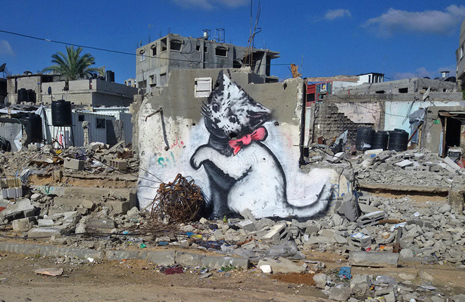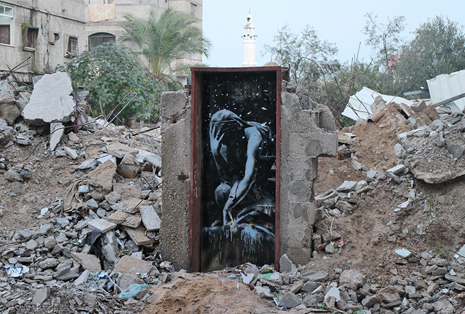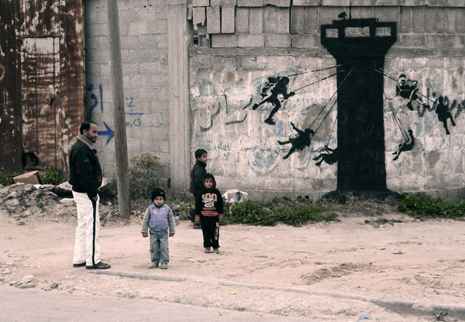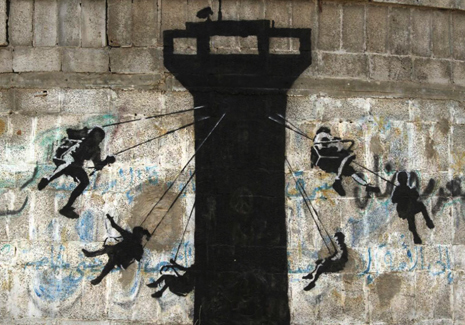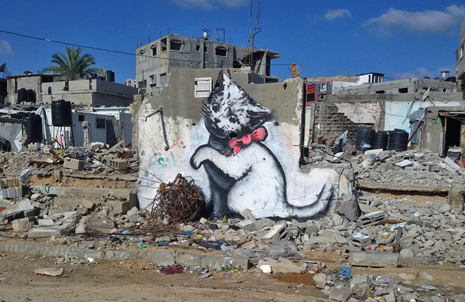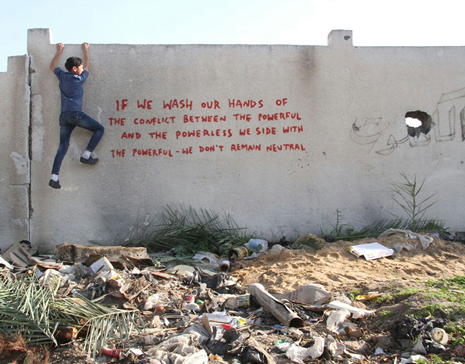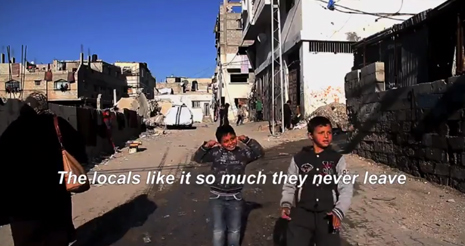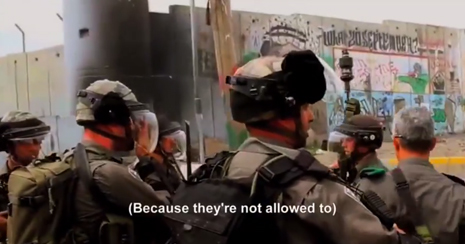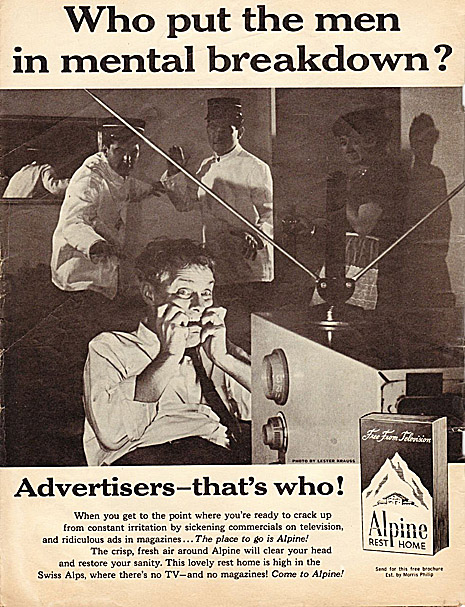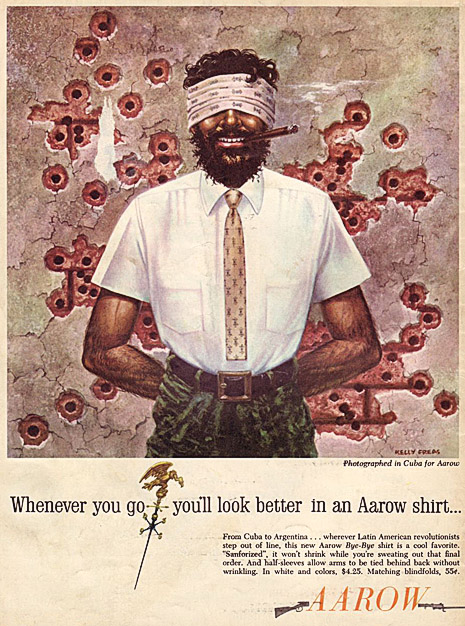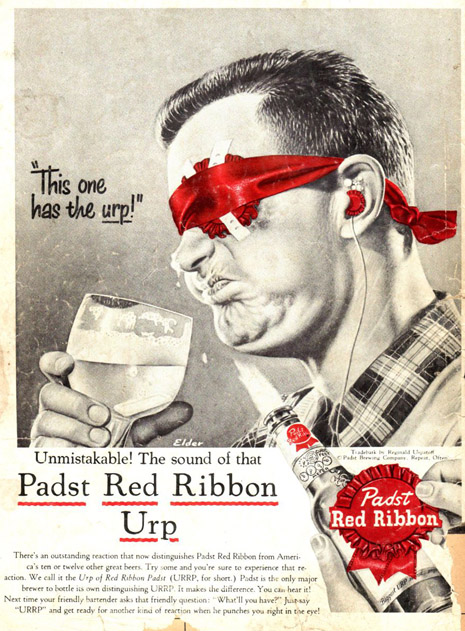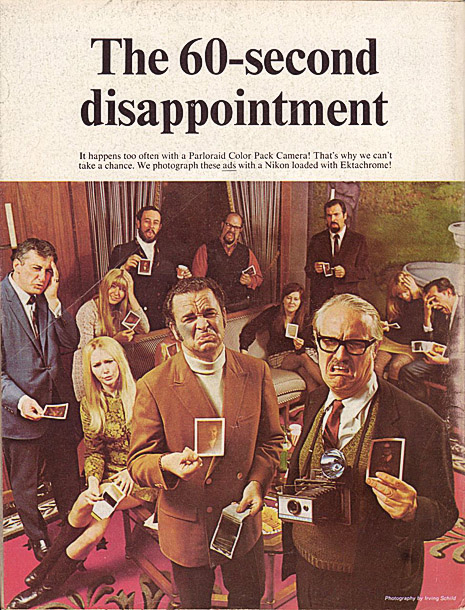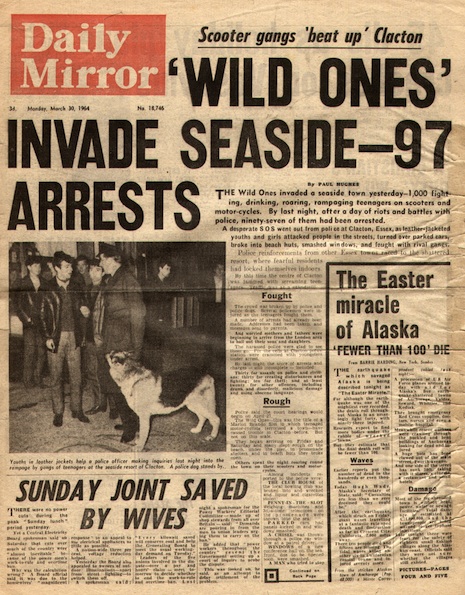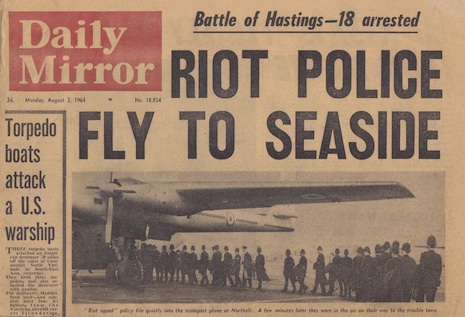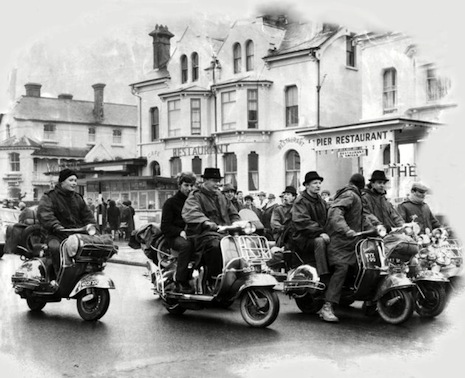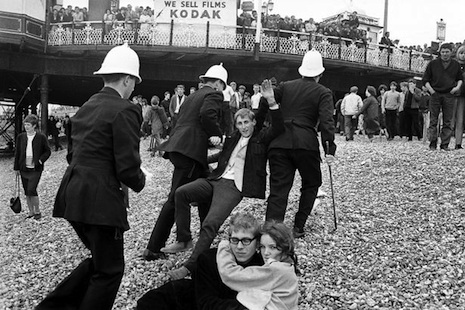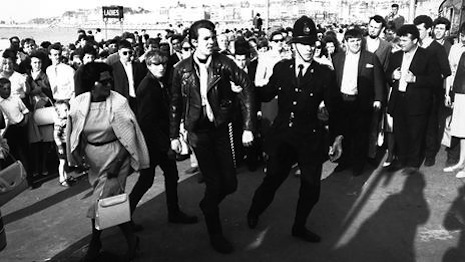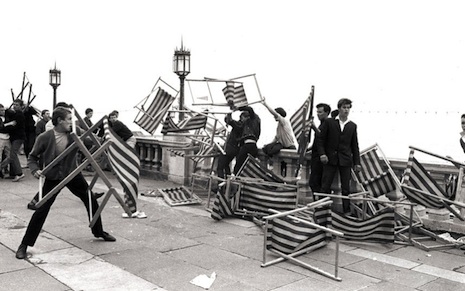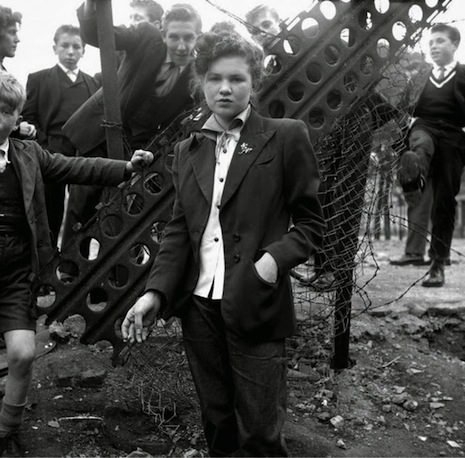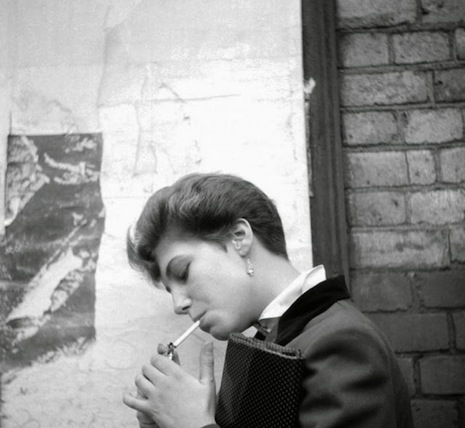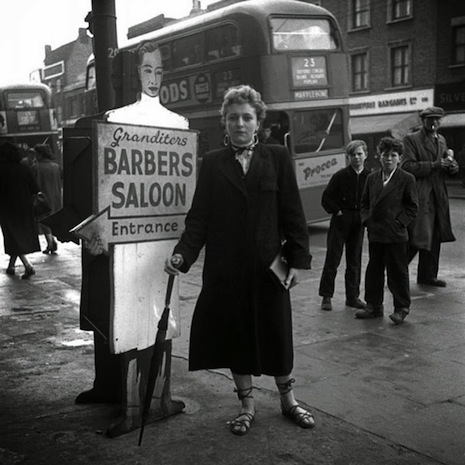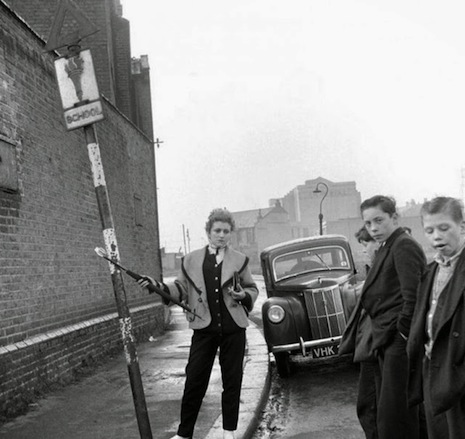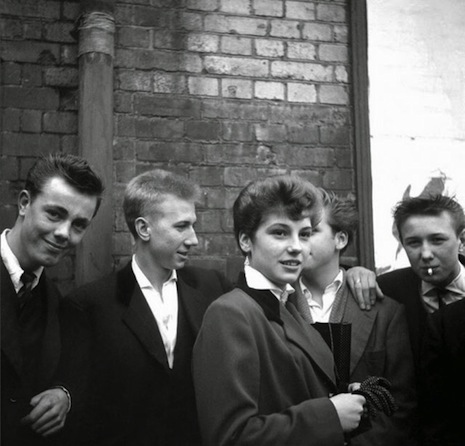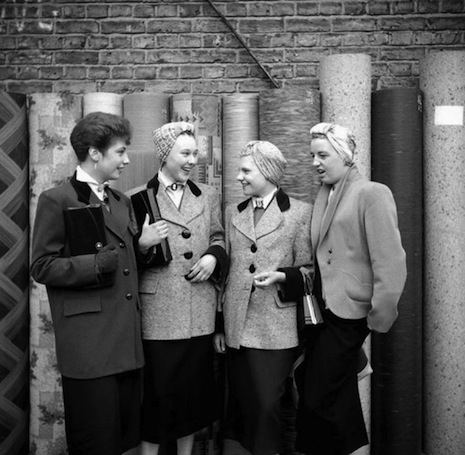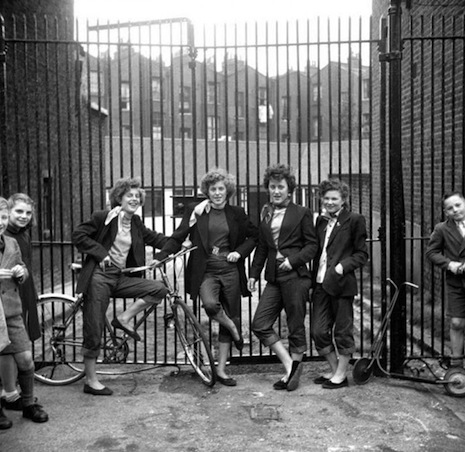Banksy’s back, and this time he’s traveled to Gaza to get the world’s attention. Never one to shy from controversy, the artist’s website was recently updated to show 4 new pieces that he spray-painted in bomb-ruined Gaza, along with a tourism-style video purportedly shot by the man himself. The 2-minute short, aimed at making a big statement about the grim situation there, is mockingly titled Make this the year YOU discover a new destination.
Here’s a look at the new stenciled art with descriptions, if given:
This one is called “Bomb Damage” and appears to be inspired by Rodin’s famous bronze sculpture, “The Thinker.”
Gaza is often described as ‘the world’s largest open air prison’ because no-one is allowed to enter or leave. But that seems a bit unfair to prisons - they don’t have their electricity and drinking water cut off randomly almost every day.
A local man came up and said ‘Please - what does this mean?’ I explained I wanted to highlight the destruction in Gaza by posting photos on my website – but on the internet people only look at pictures of kittens.
To give you a feel for it, here’s a couple stills from Make this the year YOU discover a new destination:If we wash our hands of the conflict between the powerful and the powerless we side with the powerful—we don’t remain neutral.
You can watch the video in its entirety here:
via Juxtapoz
It's in my eyes, and it doesn't look that way to me, In my eyes. - Minor Threat
Saturday, February 28, 2015
Banksy tours Gaza: creates dark, thought-provoking stencil series and video
from Dangerous Minds:
Friday, February 27, 2015
BLACK FLAG
Friday
Target Video
Black Flag's fourth and final singer Henry Rollins, early on in San Francisco
Thursday, February 26, 2015
Bridges Built For Animals
from IFL Science


Wildlife on roadways exacts a terrible cost. If the animal is large enough, it can kill the occupants of the car that hit it, and even smaller creatures can do plenty of financial damage. In addition, it is estimated that a million animals are killed on U.S. roads every day.
Sometimes there are ways to persuade animals to spend their lives on one side of a highway, but often there are good reasons for them to cross. If isolated to small pockets, species will lose genetic diversity, and can even die out when climatic conditions leave the grass insufficiently green on their side.
This is where wildlife bridges and tunnels come in. However, as this video from MinuteEarth makes clear, getting the bridge just right is not easy. What suits one species is not applicable to another, and with millions of kilometers of highways, a lot of crossings are required. Still, progress is being made.
No matter what bridge is provided, some animals will still venture onto the roadway. Let's face it, how many times have you hit a bird while driving? It's not like they don't have other options. However, well-designed bridges can cut the toll enough to keep species alive, and save the bodywork on some cars while they are at it.
Wednesday, February 25, 2015
Yes, there's footage of Prince Charles skateboarding
in a double-breasted suit, 1970s"
from Dangerous Minds:
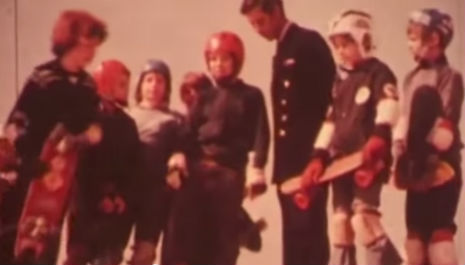
According to the YouTube uploader, this is very rare footage of a young Prince Charles skating in a double-breasted suit and dress shoes. Now since it’s on the Internet, it ain’t that rare anymore. I’ve never seen Prince Charles showing off his stellar skate moves before, but that doesn’t mean diddly-squat. (It’s an excerpt from a short doc about Charles visiting an inner city youth organization.)
But here he is in all of his future-King-of-England glory at a skatepark showing all the kiddies how it’s done. (Not really.) His feeble attempts at conversation are amusing (“So you’re an expert on that? Ah, yes. What about looping the loop?”) He claims that had he known in advance that there would be skateboarding, he’d have brought along a helmet and “the other protective paraphernalia.” Because all royals are big on safety. At least he might’ve left the wing tips at home.
Tuesday, February 24, 2015
Malcolm X
50 years ago
"This past weekend, people around the country marked the 50th anniversary of the assassination of El-Hajj Malik El-Shabazz, known as Malcolm X — one of the most influential political figures of the 20th century. In New York City, family members and former colleagues led a memorial ceremony in the former Audubon Ballroom where Malcolm X was gunned down on February 21, 1965. The Audubon Ballroom is now the Malcolm X and Betty Shabazz Memorial and Education Center."
Here's a classic program on Malcolm from Gil Noble's "Like It Is"(An incredible New York City produced television program that aired for 43 years) :
Here's a classic program on Malcolm from Gil Noble's "Like It Is"(An incredible New York City produced television program that aired for 43 years) :
Monday, February 23, 2015
MAD magazine's most vicious advertising parodies, circa 1960
from Dangerous Minds
From 1957 to 2001, Madmagazine ran no outside ads—a highly noteworthy feat. Ideally, advertising income should finance 100% of a magazine’s operating costs, materials, payroll, profit, everything, leaving actual newsstand and subscription revenues as mere icing on the cake (that’s how alt weeklies can pull off free-of-charge distribution—well, that and criminally underpaying their art directors BUT I’M NOT BITTER). Mad‘s model was such a drastic inversion of the usual magazine industry business template that, off the top of my head, I can think of few other long-running rags to pull that off—Cooks Illustrated and Consumer Reports, both of which, if I recall correctly, survive on at least some institutional support, and the horrifying Reader’s Digest, which finally began taking ads in the ‘70s, probably realizing via the success of the era’s televangelists what a goldmine of suckers their elderly right-wing audience could be.
Mad‘s late founding publisher and giant among beautiful freaks William Gaines refused ads for so long because he felt it would compromise the publication’s satirical bent. In this amusing TV segment, Gaines spelled out his rejection of advertising bluntly and succinctly:
It made sense—if for example Marlboro was paying the bills, writers might feel abashed to target Marlboro, and as it happens, Mad absolutely savaged the cigarette industry, even going so far, as you’ll see below, as to compare its death toll to Hitler’s. But so if all the revenue came from the readers alone, it was the readers alone who’d be served by the publication, and the writers and artists could freely satirize any entity they wanted to. And so they did—their advertising parodiesWe don’t believe in merchandising. We make FUN of people who suck every last dime out of a product, and so we won’t do it.
are legendary, and a Flickr user by the handle of Jasperdo has amassed an excellent collection of them. Most of them are from the late ‘50s to mid-‘60s, coinciding with the advertising industry’s so-called “creative revolution,” so naturally they all appropriate the distinctive feel of that era.
Sunday, February 22, 2015
Pussy Riot on NPR
talking about their new song abhorring police violence
Saturday, February 21, 2015
Friday, February 20, 2015
BLACK FLAG
Friday
Ron Reyes finest moments
clip from the Decline of Western Civilization film
Undoubtably Black Flag's second singer, Ron Reyes, finest moments.
Thursday, February 19, 2015
Pussy Riot
Eric Garner-Inspired Video "I Can't Breathe"
+ interview
from Pitchfork:
By Jenn Pelly
Pussy Riot Enlist Richard Hell, Yeah Yeah Yeahs' Nick Zinner, Miike Snow's Andrew Wyatt for Eric Garner-Inspired Video "I Can't Breathe"
Interview: Pussy Riot's Nadya Tolokonnikova and Masha Alyokhina discuss their first English-language song, Hell talks working with Pussy Riot
Inside a small room of the Long Island City, N.Y. contemporary art museum MoMA PS1, a work by Pussy Riot has been projected against a white wall on loop since October. It is their raw, vivid, masterfully-edited protest video, "Punk Prayer", the sub-two-minute clip that brought Pussy Riot to global consciousness in 2012, and ultimately sent Nadya Tolokonnikova and Masha Alyokhina to prison.
Now, at PS1's "Zero Tolerance" exhibit through April 13, Pussy Riot's video sits alongside work by a lineage of political artists who have fought for free speech, gay rights, and equality around the world, such as Yoko Ono and John Lennon (Bed Peace), Egypt's Amal Kenawy ("The Silence of Sheep"), Croatia's Igor Grubić ("East Side Story"), Turkey's Halil Altindere ("Wonderland"), and ACT UP New York. For the first time, Pussy Riot's work has been acknowledged by a major museum for what it is: art.
Pussy Riot's liberationist art has been occasionally lost in the swarm of its surrounding discourse. But discussion of their creative output continues today with the release of a new video for a song, their first in English, called "I Can't Breathe". The piece was inspired by the murder of Eric Garner—who died last July in Staten Island, N.Y., after a police officer put him in a chokehold—and the protests against police brutality that ensued late last year in New York. Pussy Riot dedicated the video to Garner and all those "who who suffer from state terror—killed, choked, perished because of war and police violence—to political prisoners and those on the streets fighting for change." Watch below.
The single-take video, filmed in Moscow, finds Nadya and Masha buried alive while dressed in Russian riot police uniforms. Piles of dirt are chucked onto their bodies, seeping into their teeth. A second, accompanying video (also below) was helmed by Maxim Pozdorovkin (director of the Pussy Riot film A Punk Prayer), collecting footage from the protests in New York. It documents the location of Garner's death in Staten Island, and finds members of the Garner family there lighting candles and mourning.
The music for "I Can't Breathe" was recorded in New York, produced by Pussy Riot with members of Russian bands the Jack Wood and Scofferlane, as well as several American collaborators: Yeah Yeah Yeahs' Nick Zinner (bass/piano) and Miike Snow's Andrew Wyatt (electronics), whom Pussy Riot met at a party in New York in December, as well as Shazad Ismaily (drums). But the most surprising appearance is from punk icon Richard Hell—who essentially retired from music in 1984—reciting Garner's final words at the end of the song.
"I got a call from [a publicist] saying Pussy Riot wanted to meet me," Hell explained. "I was sure somebody was gaming me, like someone was going to show up at my door and throw a pie in my face." An admirer of Pussy Riot, Hell nonetheless agreed. He invited Nadya, Masha, and friends over to his apartment, which lead to the midnight-to-6 a.m. studio session.
Hell admits he had reservations about reading Garner's words. "It felt weird to speak the words of a black man killed by the police, when I'm this privileged white guy," Hell says. "At the same time, I believe in Pussy Riot. I have faith in them. I think they're for real. It's like being an actor; you trust the director. The experience really persuaded me of their righteousness. It's a privilege to contribute this minuscule amount to what they're doing, which is devoting their lives to getting justice for people who are oppressed, who are suffering."
I exchanged emails with Pussy Riot to learn more about the video, their recent work with Le Tigre's JD Samson and Johanna Fateman, and more. The responses below were translated from Russian by Shelley Fairweather-Vega and have been edited slightly for clarity.
Pitchfork: In what ways were you inspired by the recent protests in New York City surrounding the death of Eric Garner? What do you want people to learn from the protests and this video?
Pussy Riot: Several problems that have come up in the U.S. government system resemble Russian problems in a very painful way. In particular, the problem of police violence. We are interested in seeing how the American political system, which is in general more open than the Russian one, handles defects like these, and how the media and civil society can help it or force it to fix this situation.
We are convinced that right now we need to identify other countries as examples of how we can realistically implement our ideals in Russia, which one day will become more open and free. So we are prepared to suffer through problems in other countries as if they were our own. That’s why we joined the protests in New York and wrote “I Can’t Breathe.” It truly was inspired by what happened in the U.S., but it has an attitude forged in the Russia we are living in today, in which we are trying so desperately to do something useful.
In December 2014, we were recording an anti-war song cycle in studios in New York, and when the protests started there demanding a trial for the police officer who strangled Eric Garner, it didn’t take us too much time to decide to join in. We have to demand responsibility from our governments and we can never stop reminding government bureaucrats that they exist for our sake, and not the other way around. We gave those protests our support, even though we live in Russia, because police violence and death have no nationality. Dozens of people die agonizing deaths in Russian police stations, after being beaten, or tortured, or raped. We’ve experienced police cruelty first-hand. The state’s monopoly on force must be constantly monitored by society, or else that violence will get out of control.
Pitchfork: What does the dirt represent in the video?
PR: When you get buried alive, it’s a pretty dirty process. The dirt falls on your face, and goes up your nose, and gets in your mouth and your eyes. We do end up buried underground.
Pitchfork: Did any other visual artists inspire the video? What about the medium of video art appeals to you? Does it seem more accessible than recorded music?
PR: Pussy Riot always combines the audio and visual angle. We never release songs without a video, because we are convinced that music always has a stronger impact when it comes with video. Our song is a minimalist one, and it concentrates on the beat, a metaphor for the human heartbeat in the vocals. The video also aims for minimalism. We were inspired by Lars von Trier’s Dogville, where schematic asceticism, as an artistic approach, is really perfectly implemented. Also Gaspar Noé’s Irreversible, which depicts cruelty so forcefully, and that is something that stays in the art, in the last shot, with the cameras floating upward and around in a circle. One of our goals was to show that this grave is located in no particular place. It could be anywhere. So our decisions about color—with a dark, somewhat mystical picture—are definitely the result of David Lynch’s influence. We’re big fans.
The idea of a single take is important to us. We think that is the most honest way to reduce the distance between the viewers and the people getting buried. We aren’t film directors or cinematography people. We are students of conceptual art, so each element of our video had to contain aesthetic value and also be a conceptual element. The label on the pack of cigarettes you see at the start of the video reads “Russkaya vesna,” or “Russian spring” [a term referring to Russia's aggressive militant actions in the Ukrainian war zone in 2014]. That’s not just a label. It’s the ideological construct that made Russia the way the world sees it now, burying itself and its freedom alive.
Pitchfork: Did you make any musical contributions to the song?
PR: We contribute what we can to creating the music. Some of us know how to bang on the table in rhythm, some of us do a good job catching and passing on the mood of the music, and some of us can even play instruments.
Pitchfork: How did you come to collaborate with Richard Hell, Nick Zinner and Andrew Wyatt? Why did you decide to work with white male artists on a song/video about systemic racial oppression?
PR: We went to New York with musician friends of ours from two Russian groups, Jack Wood and Scofferlane, and they also played a decisive part in creating the song: Sasha from Jack Wood is the lead vocalist, and Matvei from Scofferlane, who put together the idea for the composition and the text, also sings in the refrain.
We obviously knew about Richard Hell’s work before we met. He’s the first punk in the history of punk. It was very straightforward getting to know him. We went to visit him, and after an hour we asked, “Richard, would you like to help us record a song?” And he said, “OK, I’ll try.” Only after he arrived at the studio did we tell him that the song was dedicated to Eric Garner and we wanted him to recite his last words, because we thought that nobody else could do that like he could, honestly. He agreed.
We met Nick Zinner and Andrew Wyatt before we recorded “I Can’t Breathe,” during a rehearsal for the song “Deceptacon” by Le Tigre, which Sasha from Jack Wood sang at the Vice party. We were amazed by how responsive and patient those musicians were in devoting their time to us. The night we recorded that song at Shahzad Ismaily’s studio became a very important one for us. We realized that when it comes to freedom, protests, and the value of a single human life, people from different continents can all speak the same language.
Pitchfork: You also recently collaborated on music with JD Samson and Johanna Fateman of Le Tigre. What was that like?
PR: We recorded two pieces, punk and electronic with some references to computer games. One of those songs is coming out very soon. We still need to make the video for the other one. We’re thinking about using animation. We’re big fans of animation, especially "South Park", which we love and we think is politically important. We want to continue experimenting with getting a handle on new video genres, and in that sense we’re very open to collaboration.
Pitchfork: It seems like the idea and practice of Pussy Riot has evolved so much in the past year. What have you learned about yourselves as artists and activists since 2012?
PR: We realized that even in prison, life goes on, and you can make new discoveries even sitting behind bars. We learned a lot about people while we were in jail. They took our masks off in court in 2012, and even though it doesn’t fit in with the original concept of the group, now the world knows our faces, not just our ideas and our texts. On the one hand, that removes a certain degree of freedom. But on the other hand, you come to be better understood, because most people do want to see the face of the person they’re talking with.
Pitchfork: How would you describe the philosophy of Pussy Riot in 2015?
PR: We were convicted in 2012, and they let us out in 2014. It was hard to adapt. We left in a year full of hope for political change, and came back in a year of war, with the closing of independent media outlets and the blatant hounding of the opposition. We wanted to scream in despair, but it took us a long time figure out the shape that scream needed to take. Now, finally, we think we’ve found it, with the song and video for “I Can’t Breathe.”
2015 is just beginning, and it’s laughable to make long-term plans in this unstable political reality of ours, when a brick or riot-police club could land on your head at any moment. But we’re currently recording our anti-war cycle of songs and videos and we hope that sometime in 2015 you’ll be able to see what we’re working on right now.
Pitchfork: In the past year, you have shown work at MoMA PS1 and appeared at an event celebrating Vice's 20th anniversary. How do you view cultural institutions? Do you still consider yourselves to be punk artists? What does the word “punk” mean to you now?
PR: After getting out of jail, we founded two new institutions ourselves: an NGO called Zona Prava and an independent media outlet called MediaZona, employing more than 15 people full-time. So it’s not quite right to talk about Pussy Riot as people opposed to institutions.
A punk is someone who knows how to ask the world uncomfortable questions and does everything possible to make sure the world can’t cop out of answering those questions. A punk is a person who lives and breathes astonishment. Astonishing other people and astonishing yourself—that’s what art is for us, and without art, life can’t exist, it would be too boring. A punk is always ready to rethink the idea of what is normal, and again, first and foremost, rethink their own ideas. And if you need to use institutions to make sure the world doesn’t cop out, we’re going to use them.
Wednesday, February 18, 2015
The real Quadrophenia:
Mods vs. Rockers fight on the beaches
from Dangerous Minds
In 1964 gangs of Mods and Rockers fought battles on the very British beaches Winston Churchill had once sworn to defend.
It all kicked-off over the Easter weekend of 30th March in the holiday town of Clacton-on-Sea, south-east England. Famed for its cockles and winkles, “Kiss Me Quick” hats, amusement arcades, its eleven-hundred foot pier and golden sands on West Beach, Clacton provided the backdrop for the first major battle between the twenty-something Rockers and their teenage rivals the Mods. Clacton was reportedly “beat-up” by “scooter gangs” and 97 youth were arrested.
This was but a small rehearsal for what was to come later that year. Over the May and August bank holidays “skirmishes” involving over “thousands” of youngsters “erupted” at the seaside resorts of Margate, Broadstairs and Brighton.
In Margate there were “running battles between up to 400 teens and police on the beach as bottles were thrown amid general chaos.” But it was the fighting in Brighton that scooped the headlines, with tales of two days of “violence” and some “battles” moving further along the coast to Hastings.
The press latched onto the story of youth out of control like a terrier and squeezed every damning adjective out of it, hyping the events into a small war. Yet, these so-called “running battles” between the two rival factions were no worse than the fights between soccer fans or street gangs on a Saturday night. Still, the press and parts of the “establishment” (the police, the judges, the bishops, the local councillors and politicians…etc.) saw an opportunity to slap down the youth, and the press created a “moral panic” outraged over the falling standards of “this scepter’d isle.”
The Rockers were proto-biker gangs—they kept themselves separate from society, were bound by their own rules and rituals, and usually only fought with rival Rockers. Though considered dangerous—often referred to by the press as the “Wild Ones” after the American B-movie starring Marlon Brando—there was a sneaking admiration for the Rockers as they epitomised a macho fantasy of freedom and recklessness that most nine-to-five workers could only dream about. The Rockers also had the added appeal of being working class and fans of rock ‘n’ roll—which was more acceptable to middle England in the mid-sixties once the God-fearing Elvis had set youngsters a good example of being dutiful to one’s country by joining the US Army.
Mods on the other hand were an unknown quantity—ambitious, aspirant working class kids, politically astute, unwilling to take “no” for an answer. They were feared for their drug taking—speed was their tipple of choice—and their interest in looking good and wearing the right clothes. Dressing sharp was considered “suspect” and if not exactly effeminate, being fashion-conscious was not an attribute traditionally thought of as a masculine one. For an older generation, the Mods were the face of the future looming—the red brick universities, the council estate, the supermarkets, the motorways and self-service restaurants—these entitled brats were the very children for whom they had fought a war.
The events of that heady summer inspired The Who’s Pete Townshend to write his rock opera Quadrophenia. Anthony Burgess, who was never shy about making a headline, said his book A Clockwork Orange had been inspired by these “loutish” and “hoodlum” youth—even though his book had been published in 1962. Fifty years after the infamous “fighting on the beaches,” the BBC made a documentary revisiting the Mods, Rockers and Bank Holiday Mayhem that interviewed some of the youngsters who were there.
The intention of the filmmakers in this short extract from the “exploitation” documentary Primitive London is to take a pop at tribal youth culture and its fashions. The four youth cultures briefly examined are Mods, Rockers, Beatniks and those who fall outside of society.
The Mods are dismissed as “peacocks;” the Rockers are seen as lumpen and shall we say knuckle-dragging; the Beatniks don’t really know what they believe in as they are against everything, man; and finally there are the ones who are not part of any group as they consider themselves to be outside of society—apparently these guys “dissipate their identity in complete passivity”—now that sounds like a group I’d join.
Mostly it’s all about the Beatniks, who are filmed hanging out in their local bar getting drunk, answering questions on fashion, work, marriage and all the other concerns middle-aged producers thought were important in 1965. As a footnote, the bar seen in this clip is the one where Rod Stewart (aka Rod the Mod) hung out. The featured musicians are Ray Sone, harp (later of The Downliners Sect) and Emmett Hennessy, vocals, guitar.
Tuesday, February 17, 2015
What Would Happen To Earth If All Humans Disappeared?
From IFLScience.com (I Fucking Love Science)


Snap! You’re gone.
If this happened to every human on Earth at the exact same time, what consequences would ensue? This thought experiment not only explores the impact humanity has on the planet, but also the incredible resilience of nature.
So what would transpire? First of all, power plants would run out of fuel and electrical fences would cease to work, releasing nearly 1.5 billion cows, 1 billions pigs and 20 billion chickens into the wild. Roadways would turn into rivers, wood houses would catch on fire, concrete buildings would crumble, and yet, one thing would remain—our plastic
Monday, February 16, 2015
The Last of the Teddy Girls’:
Ken Russell’s nearly lost photographs
of London’s teenage girl gangs
from Dangerous Minds:
Though Ken Russell wanted to be a ballet dancer, his father wouldn’t hear of it—no son of his would ever be seen in tights—so the young Russell turned his attention to photography, a craft he thought he could make his name with. He attended Walthamstow Technical College in London, where he was taught all about lighting and composition. Russell would later claim that everything he did as a trainee photographer broke the rules—a trend he continued throughout his career as a film director when producing such acclaimed movies as Women in Love, The Music Lovers, The Devils, Tommy, Altered States and Crimes of Passion.
Russell became a photographer for Picture Post and the Illustrated Magazine, and during his time with these publications took some of the most evocative photos of post-war London during the 1950s. He spent his days photographing street scenes and his nights printing his pictures on the kitchen table of his rented one-bed apartment in Notting Hill.
For fifty years, it was believed Russell’s photos had been lost, but in 2005 a box marked “Ken Russell” was discovered in the archives of a photo library. Inside was over 3,000 of Ken’s negatives.
Among his most famous work from this period is “The Last of the Teddy Girls”—a series of photos documenting London’s girl gang subculture and their male counterparts. Russell was attracted to these young women for their sense of independence and style—dressing in suits, land army clothes—while rejecting society’s expectations of more traditional, feminine roles. (Teddy kids of either sex were known for fights breaking out wherever they congregated.) The images show Russell’s innate talent for composition and offer a fascinating look into a rarely documented female subculture.
Via Vintage Everyday.
Sunday, February 15, 2015
Twenty Eight Years Ago Today
We do the shoot for PE's 1st LP cover
According to my man Chuck D.'s twitter account where he posted the back cover image we shot for "Yo Bum Rush The Show"
this happened twenty eight years ago to the day... out in Hempstead Long Island on a cold cold night into the wee hours.
this happened twenty eight years ago to the day... out in Hempstead Long Island on a cold cold night into the wee hours.
@MrChuckD : Not to brag but I knew when I took these shots they'd still look cool 28 years later regardless what was trending pic.twitter.com/zmz9jebFpP

